Unit 2 Ways to go to school 同步练习卷 (含答案)
文档属性
| 名称 | Unit 2 Ways to go to school 同步练习卷 (含答案) | 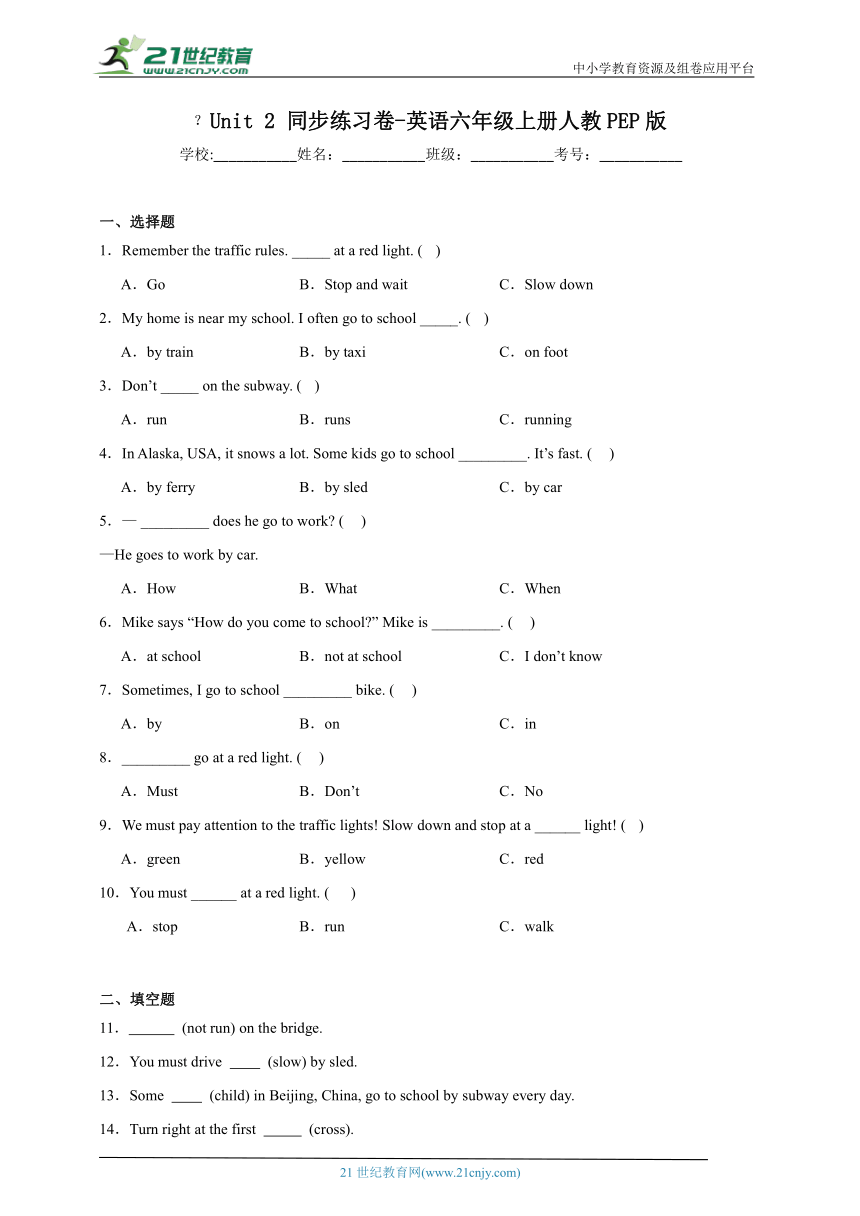 | |
| 格式 | docx | ||
| 文件大小 | 554.6KB | ||
| 资源类型 | 试卷 | ||
| 版本资源 | 人教版(PEP) | ||
| 科目 | 英语 | ||
| 更新时间 | 2025-07-27 14:26:31 | ||
图片预览

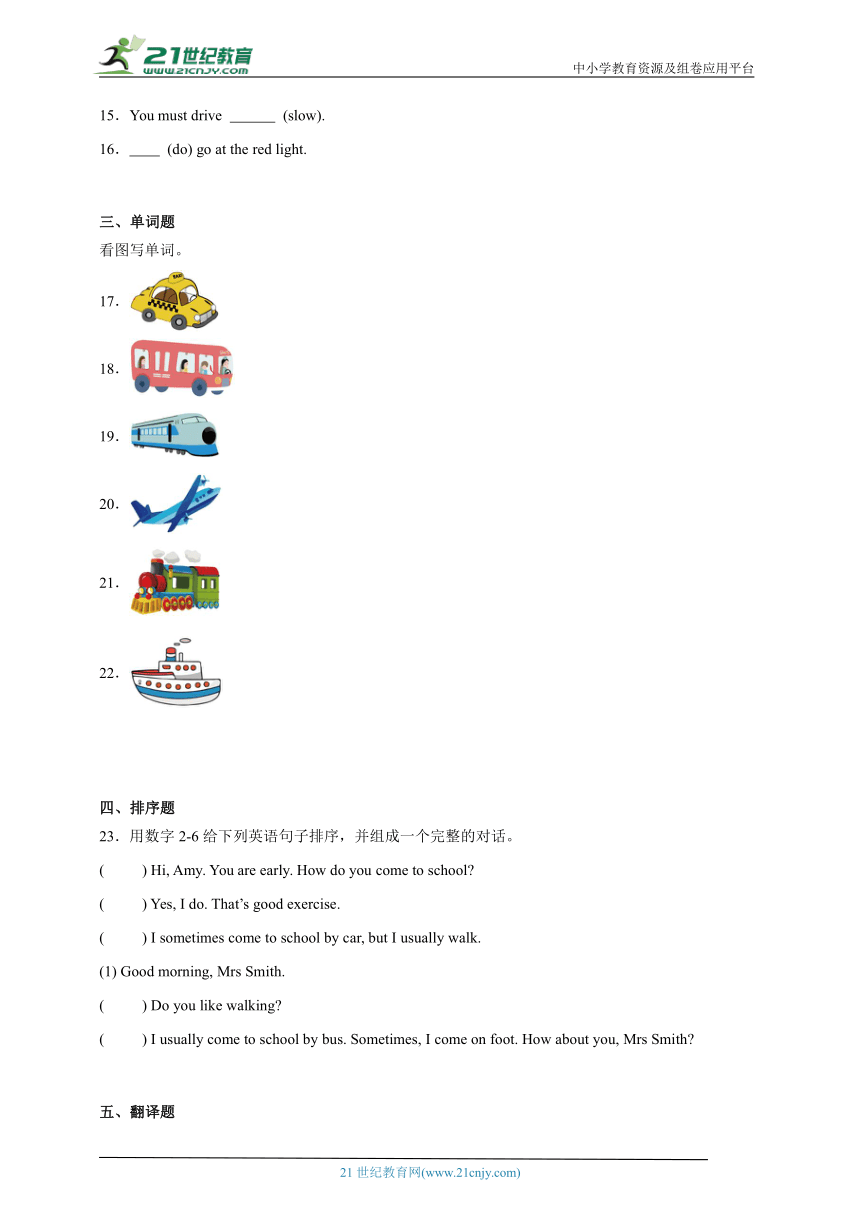
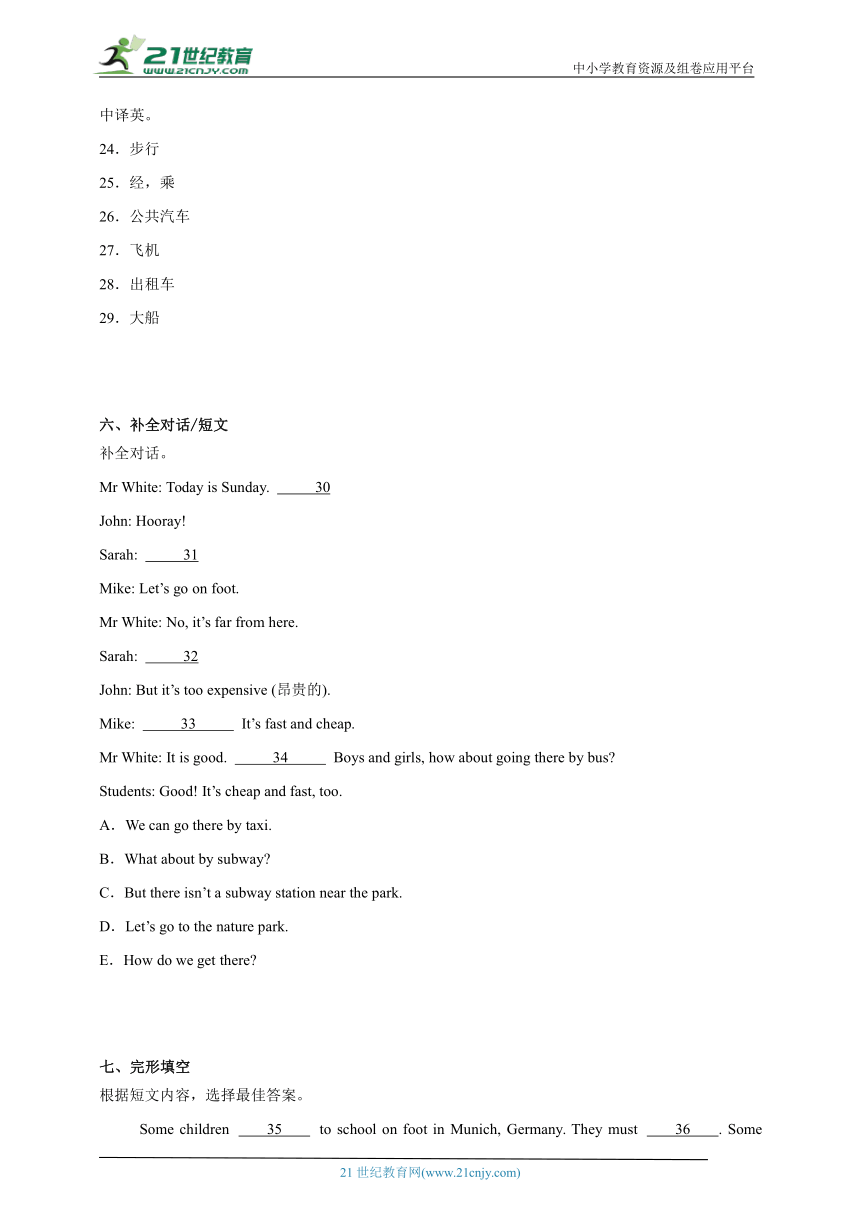
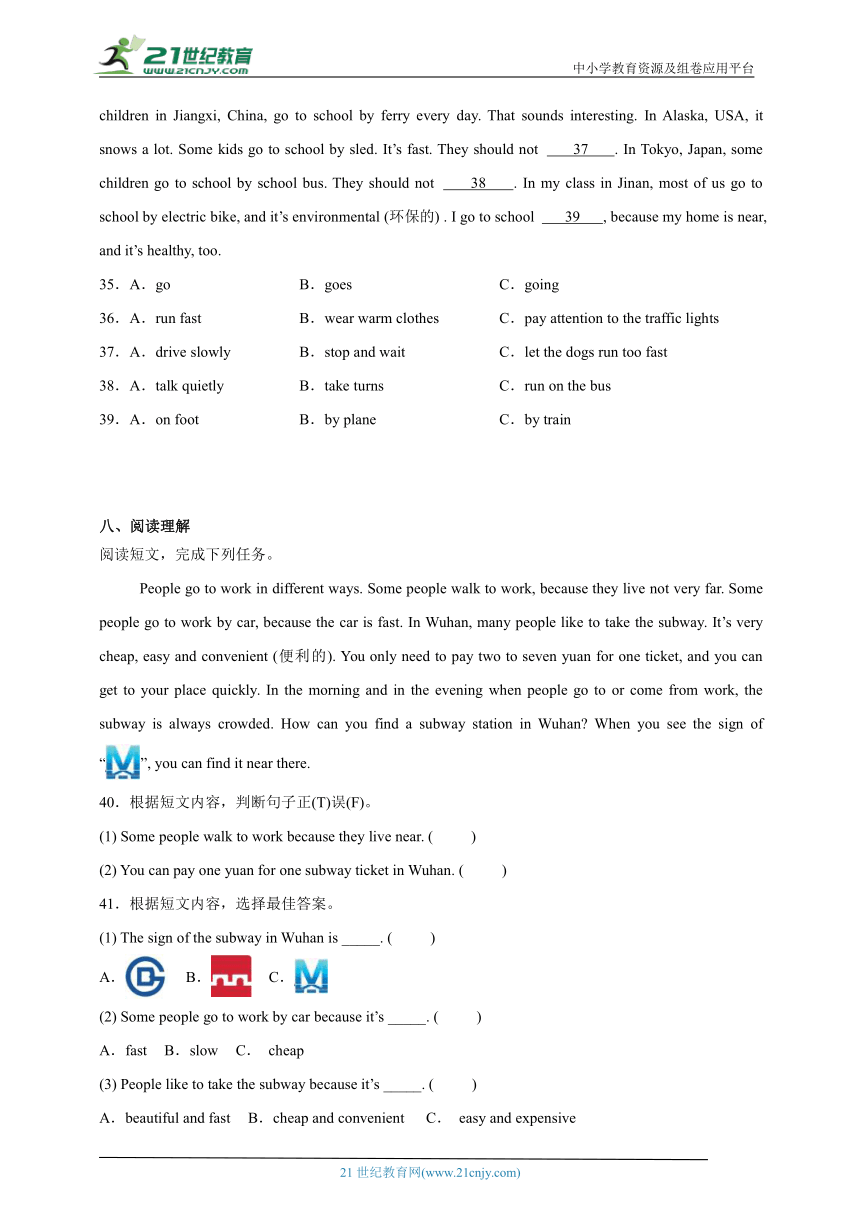
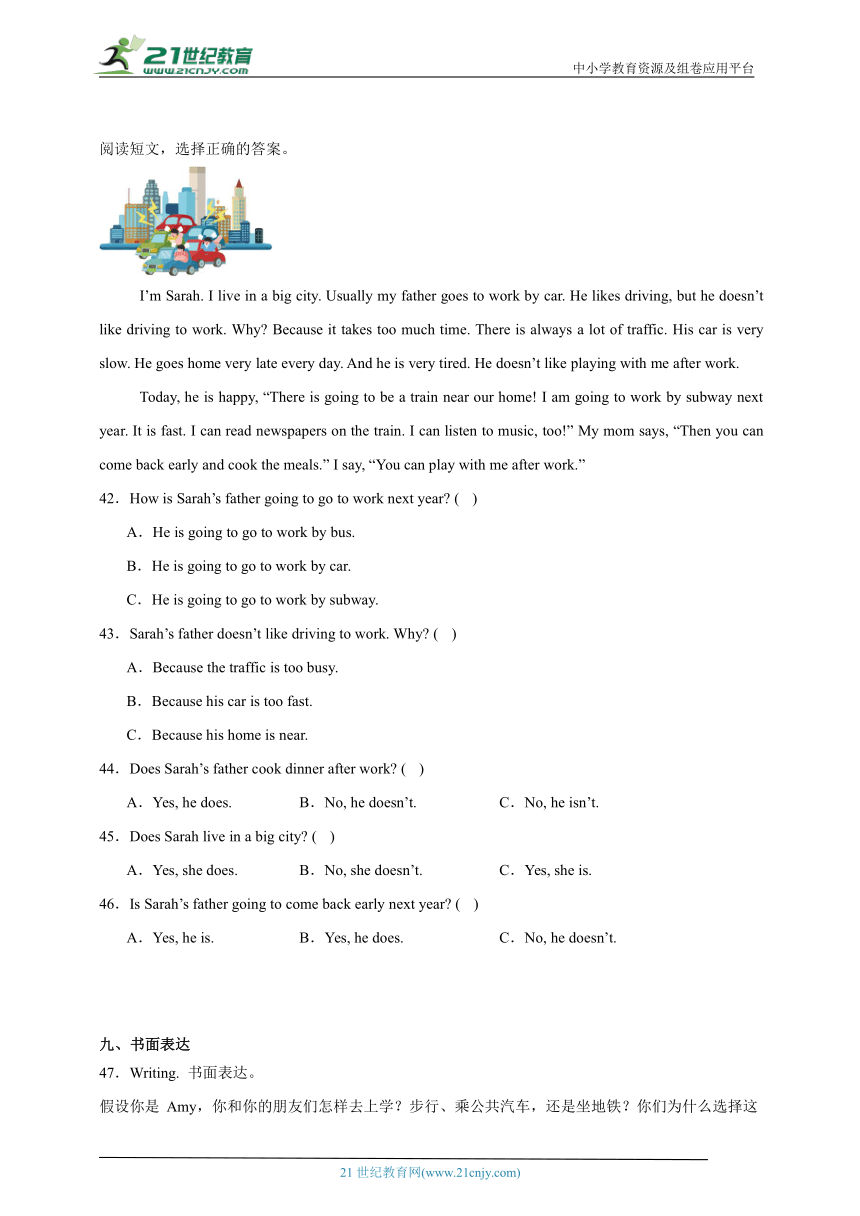
文档简介
中小学教育资源及组卷应用平台
?Unit 2 同步练习卷-英语六年级上册人教PEP版
学校:___________姓名:___________班级:___________考号:___________
一、选择题
1.Remember the traffic rules. _____ at a red light. ( )
A.Go B.Stop and wait C.Slow down
2.My home is near my school. I often go to school _____. ( )
A.by train B.by taxi C.on foot
3.Don’t _____ on the subway. ( )
A.run B.runs C.running
4.In Alaska, USA, it snows a lot. Some kids go to school _________. It’s fast. ( )
A.by ferry B.by sled C.by car
5.— _________ does he go to work ( )
—He goes to work by car.
A.How B.What C.When
6.Mike says “How do you come to school ” Mike is _________. ( )
A.at school B.not at school C.I don’t know
7.Sometimes, I go to school _________ bike. ( )
A.by B.on C.in
8._________ go at a red light. ( )
A.Must B.Don’t C.No
9.We must pay attention to the traffic lights! Slow down and stop at a ______ light! ( )
A.green B.yellow C.red
10.You must ______ at a red light. ( )
A.stop B.run C.walk
二、填空题
11. (not run) on the bridge.
12.You must drive (slow) by sled.
13.Some (child) in Beijing, China, go to school by subway every day.
14.Turn right at the first (cross).
15.You must drive (slow).
16. (do) go at the red light.
三、单词题
看图写单词。
17.
18.
19.
20.
21.
22.
四、排序题
23.用数字2-6给下列英语句子排序,并组成一个完整的对话。
( ) Hi, Amy. You are early. How do you come to school
( ) Yes, I do. That’s good exercise.
( ) I sometimes come to school by car, but I usually walk.
(1) Good morning, Mrs Smith.
( ) Do you like walking
( ) I usually come to school by bus. Sometimes, I come on foot. How about you, Mrs Smith
五、翻译题
中译英。
24.步行
25.经,乘
26.公共汽车
27.飞机
28.出租车
29.大船
六、补全对话/短文
补全对话。
Mr White: Today is Sunday. 30
John: Hooray!
Sarah: 31
Mike: Let’s go on foot.
Mr White: No, it’s far from here.
Sarah: 32
John: But it’s too expensive (昂贵的).
Mike: 33 It’s fast and cheap.
Mr White: It is good. 34 Boys and girls, how about going there by bus
Students: Good! It’s cheap and fast, too.
A.We can go there by taxi.
B.What about by subway
C.But there isn’t a subway station near the park.
D.Let’s go to the nature park.
E.How do we get there
七、完形填空
根据短文内容,选择最佳答案。
Some children 35 to school on foot in Munich, Germany. They must 36 . Some children in Jiangxi, China, go to school by ferry every day. That sounds interesting. In Alaska, USA, it snows a lot. Some kids go to school by sled. It’s fast. They should not 37 . In Tokyo, Japan, some children go to school by school bus. They should not 38 . In my class in Jinan, most of us go to school by electric bike, and it’s environmental (环保的) . I go to school 39 , because my home is near, and it’s healthy, too.
35.A.go B.goes C.going
36.A.run fast B.wear warm clothes C.pay attention to the traffic lights
37.A.drive slowly B.stop and wait C.let the dogs run too fast
38.A.talk quietly B.take turns C.run on the bus
39.A.on foot B.by plane C.by train
八、阅读理解
阅读短文,完成下列任务。
People go to work in different ways. Some people walk to work, because they live not very far. Some people go to work by car, because the car is fast. In Wuhan, many people like to take the subway. It’s very cheap, easy and convenient (便利的). You only need to pay two to seven yuan for one ticket, and you can get to your place quickly. In the morning and in the evening when people go to or come from work, the subway is always crowded. How can you find a subway station in Wuhan When you see the sign of “”, you can find it near there.
40.根据短文内容,判断句子正(T)误(F)。
(1) Some people walk to work because they live near. ( )
(2) You can pay one yuan for one subway ticket in Wuhan. ( )
41.根据短文内容,选择最佳答案。
(1) The sign of the subway in Wuhan is _____. ( )
A. B. C.
(2) Some people go to work by car because it’s _____. ( )
A.fast B.slow C. cheap
(3) People like to take the subway because it’s _____. ( )
A.beautiful and fast B.cheap and convenient C. easy and expensive
阅读短文,选择正确的答案。
I’m Sarah. I live in a big city. Usually my father goes to work by car. He likes driving, but he doesn’t like driving to work. Why Because it takes too much time. There is always a lot of traffic. His car is very slow. He goes home very late every day. And he is very tired. He doesn’t like playing with me after work.
Today, he is happy, “There is going to be a train near our home! I am going to work by subway next year. It is fast. I can read newspapers on the train. I can listen to music, too!” My mom says, “Then you can come back early and cook the meals.” I say, “You can play with me after work.”
42.How is Sarah’s father going to go to work next year ( )
A.He is going to go to work by bus.
B.He is going to go to work by car.
C.He is going to go to work by subway.
43.Sarah’s father doesn’t like driving to work. Why ( )
A.Because the traffic is too busy.
B.Because his car is too fast.
C.Because his home is near.
44.Does Sarah’s father cook dinner after work ( )
A.Yes, he does. B.No, he doesn’t. C.No, he isn’t.
45.Does Sarah live in a big city ( )
A.Yes, she does. B.No, she doesn’t. C.Yes, she is.
46.Is Sarah’s father going to come back early next year ( )
A.Yes, he is. B.Yes, he does. C.No, he doesn’t.
九、书面表达
47.Writing. 书面表达。
假设你是 Amy,你和你的朋友们怎样去上学?步行、乘公共汽车,还是坐地铁?你们为什么选择这种方式?你们会注意 (pay attention to) 路边的交通信号灯 (traffic lights) 吗? 请以“Ways to go to school”为题,写一篇短文,介绍一下你们的上学方式吧!
要求: 1. 紧扣主题,意思连贯,语言通顺,书写规范。
2. 不少于 50 词。
Ways to go to school
____________________________________________________________________________________________
____________________________________________________________________________________________
____________________________________________________________________________________________
____________________________________________________________________________________________
____________________________________________________________________________________________
《Unit 2 同步练习卷-英语六年级上册人教PEP版》参考答案
题号 1 2 3 4 5 6 7 8 9 10
答案 B C A B A A A B C A
题号 35 36 37 38 39
答案 A C C C A
1.B
【详解】句意:记住交通规则,红灯时______。本题考查动词短语和动词辨析。A走,B停下等待,C减速。根据常识,红灯时应“停下等待”,选项B符合题意,故选B。
2.C
【详解】句意:我家离学校很近。我经常步行上学。本题考查介词固定搭配。A乘火车,B乘出租车,C步行。根据句意可知,学校离家近,最合理的方式是步行,故选C。
3.A
【详解】句意:不要在地铁上奔跑。本题考查祈使句的否定形式。祈使句的否定结构为“Don’t + 动词原形”,表示禁止或劝阻。选项中只有A(run)是动词原形,符合语法规则。故选A。
4.B
【详解】句意:在美国阿拉斯加,经常下雪,一些孩子乘______去上学。这很快。本题考查交通工具的语境应用。阿拉斯加多雪,雪橇(sled)是雪地中快速且常用的交通工具,符合“fast”的描述。A乘渡船,C坐汽车,不符合题意。故选B。
5.A
【详解】句意:—他怎么去上班?—他开车去上班。本题考查疑问词的选择。答句“by car”表示交通方式,需用询问方式的疑问词“How”。B什么,C什么时候,不符合题意。故选A。
6.A
【详解】句意:迈克说“你怎么来学校?”,迈克_________。本题考查陈述句及语境理解。根据come to school来学校,可知迈克在学校,A在学校,B不在学校,C我不知道,故选A。
7.A
【详解】句意:有时,我骑自行车去上学。本题考查介词与交通工具的固定搭配。表示使用某种交通工具时,“by + 交通工具(单数,无冠词)”是固定用法,如by bike(骑自行车)。选项中只有A符合这一规则。故选A。
8.B
【详解】句意:红灯时不要走。本题考查祈使句的否定形式。否定祈使句的结构为“Don’t + 动词原形+其他。”,表示禁止或劝阻。选项B“Don’t”符合此结构,正确表达“红灯时禁止通行”。选项C“No”需接动名词(如“No going”),不能直接接动词原形。故选B。
9.C
【详解】句意:我们必须注意交通灯!在红灯处减速并停下来!本题考查形容词辨析。A绿色的,B黄色的,C红色的,根据题干说减速并停下来,可知是红灯,故选C。
10.A
【详解】句意:红灯时你必须停下。本题考查动词辨析。A停,B跑,C走路。根据交通规则,红灯时应停止前进,故选A。
11.
Don’t run
【详解】句意:不要在桥上跑。本题考查祈使句的否定形式。祈使句的否定结构为“Don’t + 动词原形+其他。”,用于表达禁止或劝告。故答案为Don’t run。
12.
slowly
【详解】句意:你必须用雪橇缓慢驾驶。本题考查副词的用法。括号中给出的词是形容词,该空应用副词修饰动词drive,slow的副词是slowly。故答案为slowly。
13.
children
【详解】句意:在中国北京,一些孩子每天乘地铁上学。本题考查可数名词及其单复数。some后接可数名词复数,child的复数形式为不规则变化的children。故答案为children。
14.crossing
【详解】句意:在第一个十字路口右转。本题考查可数名词及其单复数。cross穿过,动词,该处用名词crossing十字路口,根据first可知用单数。故答案为crossing。
15.slowly
【详解】句意:你必须慢慢地驾驶。本题考查副词的用法。drive驾驶,后面要用副词修饰。slow慢的,是形容词,副词形式为slowly,故答案为slowly。
16.Don’t
【详解】句意:在红灯处不要走。本题考查祈使句的否定形式,don’t+动词原形+其他,故答案为Don’t。
17.taxi 18.bus 19.subway 20.plane 21.train 22.ship
【解析】17.图中是一辆出租车,taxi出租车,符合题意,故答案为taxi。
18.图中是一辆公交车,bus公交车,符合题意,故答案为bus。
19.图中是一列地铁,subway地铁,符合题意,故答案为subway。
20.图中是一架飞机,plane飞机,符合题意,故答案为plane。
21.图中是一列火车,train火车,符合题意,故答案为train。
22.图中是一艘轮船,ship轮船,符合题意,故答案为ship。
23. 2 6 4 5 3
【分析】所给各句汉语意思:
你好,艾米。你很早。你怎么来学校?
是的,我喜欢。这是很好的锻炼。
我有时开车来学校,但我通常步行。
早上好,史密斯夫人。
你喜欢步行吗?
我通常坐公共汽车来学校。有时我步行来。你呢,史密斯夫人?
根据句子汉语意思可知对话大意为:讨论交通方式。
【详解】问候史密斯夫人早上好,已给出—问艾米怎么来学校—回答通常坐公共汽车,有时步行,并问史密斯夫人怎么来学校—回答有时开车,通常步行来—问喜欢步行吗—回答喜欢并说是很好的锻炼。故答案为2,6,4,5,3。
24.on foot 25.by 26.bus 27.plane 28.taxi 29.ship
【解析】24.步行的英文是on foot,故答案为on foot。
25.经,乘的英文是by,故答案为by。
26.公共汽车的英文是bus,故答案为bus。
27.飞机的英文是plane,故答案为plane。
28.出租车的英文是taxi,故答案为taxi。
29.大船的英文是ship,故答案为ship。
30.D 31.E 32.A 33.B 34.C
【导语】本文主要谈论的是去自然公园的交通方式。
30.下句说:万岁!可知选项D“我们去自然公园吧。”符合语境,故选D。
31.下句说:我们步行去吧。可知这句是问怎么去,选项E“我们怎么去那里?”符合语境,故选E。
32.上句说:不,离这里很远。可知这句是说另一种交通工具,根据下句“But it’s too expensive.”,可知选项A“我们可以乘出租车去那里。”符合语境,故选A。
33.下句说:它既快又便宜。可知这句是说乘地铁去,选项B“乘地铁怎么样?”符合语境,故选B。
34.下句说:孩子们,坐公交车去那儿怎么样?可知这句是说乘地铁不行,选项C“但公园附近没有地铁站。”符合语境,故选C。
35.A 36.C 37.C 38.C 39.A
【导语】本文讲述了各国学生上学的方式。
35.句意:在德国慕尼黑,一些孩子步行去上学。A动词原形,B动词第三人称单数,C动名词。根据句意可知,此处是在陈述客观事实,时态应为一般现在时,主语为some children,谓语动词用原形,故选A。
36.句意:他们必须________。A快点跑,B穿暖和的衣服,C注意交通灯。上句说在德国慕尼黑,一些孩子步行去上学,可知他们应该注意交通灯,故选C。
37.句意:他们不应该________。A慢点驾驶,B停下并等候,C让狗跑得太快。根据文中“In Alaska, USA, it snows a lot. Some kids go to school by sled. It’s fast.”及句子逻辑可知,为了安全考虑,他们不应该让拉雪橇的狗跑得太快。故选C。
38.句意:她们不应该________。A安静的交谈,B按顺序轮流,C在校车上奔跑。根据文中“In Tokyo, Japan, some children go to school by school bus. ”及句子逻辑可知,为了安全考虑,他们不应该在校车上奔跑,故选C。
39.句意:我________去上学,因为我家很近,而且这种方式很健康。A步行,B乘飞机,C乘火车。根据文中“because my home is near, and it’s healthy, too.”可推断出作者应该是步行上学,故选A。
40. T F 41. C A B
【导语】本文讲了交通方式。
40.(1)句意:一些人步行去上学,因为他们住得近。根据“Some people walk to work, because they live not very far.”,可知题干与短文相符,故答案为T。
(2)句意:在武汉,你可以花一元买一张地铁票。根据“You only need to pay two to seven yuan for one ticket, and you can get to your place quickly.”,可知一张票2-7元,故答案为F。
41.(1)句意:武汉地铁的标志是_______。根据“When you see the sign of “ ”, you can find it near there.”,可知武汉地铁的标志是,故选C。
(2)句意:一些人开车去上班,因为这很_______。A快的,B慢的,C便宜的,根据“Some people go to work by car, because the car is fast.”,可知是因为快,故选A。
(3)句意:人们喜欢乘坐地铁,因为这很________。A漂亮且快,B便宜且方便,C容易且贵,根据“In Wuhan, many people like to take the subway. It’s very cheap, easy and convenient (便利的).”,可知因为便宜且方便,故选B。
42.C 43.A 44.B 45.A 46.A
【导语】本文主要讲了莎拉的爸爸的出行方式以及对生活的影响。
42.句意:明年莎拉的爸爸将要如何去上班?A他将要乘公交车去上班。B他将要乘小汽车去上班。C他将要乘地铁去上班。根据文中“I am going to work by subway next year. ”可知,莎拉的爸爸明年将要乘地铁去上班,选项C符合题意,故选C。
43.句意:莎拉的爸爸不喜欢开车去上班。为什么?A因为交通拥堵。B因为汽车太快了。C因为他的家很近。根据文中“He likes driving, but he doesn’t like driving to work. Why Because it takes too much time. There is always a lot of traffic. His car is very slow. He goes home very late every day. ”可知,莎拉的爸爸不喜欢开车上班的原因是交通拥堵,汽车开的很慢,以至于使他每天都很晚回家,选项A符合题意,故选A。
44.句意:莎拉的爸爸下班后做晚餐吗?A是的,他做。B不,他不做。C不,他不是。根据文中“He goes home very late every day. And he is very tired.”可知,莎拉的爸爸每天回家很晚,并且非常累,没有时间做晚餐,选项B符合题意,故选B。
45.句意:莎拉住在一个大城市吗?A是的,她住在那里。B不,她不住那里。C是的,她是。根据文中“I’m Sarah. I live in a big city.”可知,莎拉住在一个大城市里,选项A符合题意,故选A。
46.句意:明年莎拉的爸爸将会回来早一点吗?A是的,他会。B是的,他做。C不,他不做。根据文中“My mom says, ‘Then you can come back early and cook the meals.’”可知,莎拉的爸爸明年会回来早一点,选项A符合题意,故选A。
47.范文:
Ways to go to school
I’m Amy. I often go to school by bus. It’s fast. Bob lives near the school. He usually walks to school. It’s good exercise. Peter likes riding his bike. He often goes to school by bike. Kate lives far from the school. She usually goes to school by subway. We always pay attention to the traffic lights.
【详解】1. 题干解读:该题目要求假如自己是Amy,以“Ways to go to school”为题,写一篇短文。然后再阐述自己和朋友上学的交通方式。注意文章为一般现在时态并要符合单词字数要求。
2. 参考词汇与句型:
参考单词:by bus坐公共汽车,walk to school步行去学校,by bike骑自行车,far from远离,by subway坐地铁,pay attention to注意
参考句型:I’m …; I often …;He/She …
21世纪教育网 www.21cnjy.com 精品试卷·第 2 页 (共 2 页)
21世纪教育网(www.21cnjy.com)
?Unit 2 同步练习卷-英语六年级上册人教PEP版
学校:___________姓名:___________班级:___________考号:___________
一、选择题
1.Remember the traffic rules. _____ at a red light. ( )
A.Go B.Stop and wait C.Slow down
2.My home is near my school. I often go to school _____. ( )
A.by train B.by taxi C.on foot
3.Don’t _____ on the subway. ( )
A.run B.runs C.running
4.In Alaska, USA, it snows a lot. Some kids go to school _________. It’s fast. ( )
A.by ferry B.by sled C.by car
5.— _________ does he go to work ( )
—He goes to work by car.
A.How B.What C.When
6.Mike says “How do you come to school ” Mike is _________. ( )
A.at school B.not at school C.I don’t know
7.Sometimes, I go to school _________ bike. ( )
A.by B.on C.in
8._________ go at a red light. ( )
A.Must B.Don’t C.No
9.We must pay attention to the traffic lights! Slow down and stop at a ______ light! ( )
A.green B.yellow C.red
10.You must ______ at a red light. ( )
A.stop B.run C.walk
二、填空题
11. (not run) on the bridge.
12.You must drive (slow) by sled.
13.Some (child) in Beijing, China, go to school by subway every day.
14.Turn right at the first (cross).
15.You must drive (slow).
16. (do) go at the red light.
三、单词题
看图写单词。
17.
18.
19.
20.
21.
22.
四、排序题
23.用数字2-6给下列英语句子排序,并组成一个完整的对话。
( ) Hi, Amy. You are early. How do you come to school
( ) Yes, I do. That’s good exercise.
( ) I sometimes come to school by car, but I usually walk.
(1) Good morning, Mrs Smith.
( ) Do you like walking
( ) I usually come to school by bus. Sometimes, I come on foot. How about you, Mrs Smith
五、翻译题
中译英。
24.步行
25.经,乘
26.公共汽车
27.飞机
28.出租车
29.大船
六、补全对话/短文
补全对话。
Mr White: Today is Sunday. 30
John: Hooray!
Sarah: 31
Mike: Let’s go on foot.
Mr White: No, it’s far from here.
Sarah: 32
John: But it’s too expensive (昂贵的).
Mike: 33 It’s fast and cheap.
Mr White: It is good. 34 Boys and girls, how about going there by bus
Students: Good! It’s cheap and fast, too.
A.We can go there by taxi.
B.What about by subway
C.But there isn’t a subway station near the park.
D.Let’s go to the nature park.
E.How do we get there
七、完形填空
根据短文内容,选择最佳答案。
Some children 35 to school on foot in Munich, Germany. They must 36 . Some children in Jiangxi, China, go to school by ferry every day. That sounds interesting. In Alaska, USA, it snows a lot. Some kids go to school by sled. It’s fast. They should not 37 . In Tokyo, Japan, some children go to school by school bus. They should not 38 . In my class in Jinan, most of us go to school by electric bike, and it’s environmental (环保的) . I go to school 39 , because my home is near, and it’s healthy, too.
35.A.go B.goes C.going
36.A.run fast B.wear warm clothes C.pay attention to the traffic lights
37.A.drive slowly B.stop and wait C.let the dogs run too fast
38.A.talk quietly B.take turns C.run on the bus
39.A.on foot B.by plane C.by train
八、阅读理解
阅读短文,完成下列任务。
People go to work in different ways. Some people walk to work, because they live not very far. Some people go to work by car, because the car is fast. In Wuhan, many people like to take the subway. It’s very cheap, easy and convenient (便利的). You only need to pay two to seven yuan for one ticket, and you can get to your place quickly. In the morning and in the evening when people go to or come from work, the subway is always crowded. How can you find a subway station in Wuhan When you see the sign of “”, you can find it near there.
40.根据短文内容,判断句子正(T)误(F)。
(1) Some people walk to work because they live near. ( )
(2) You can pay one yuan for one subway ticket in Wuhan. ( )
41.根据短文内容,选择最佳答案。
(1) The sign of the subway in Wuhan is _____. ( )
A. B. C.
(2) Some people go to work by car because it’s _____. ( )
A.fast B.slow C. cheap
(3) People like to take the subway because it’s _____. ( )
A.beautiful and fast B.cheap and convenient C. easy and expensive
阅读短文,选择正确的答案。
I’m Sarah. I live in a big city. Usually my father goes to work by car. He likes driving, but he doesn’t like driving to work. Why Because it takes too much time. There is always a lot of traffic. His car is very slow. He goes home very late every day. And he is very tired. He doesn’t like playing with me after work.
Today, he is happy, “There is going to be a train near our home! I am going to work by subway next year. It is fast. I can read newspapers on the train. I can listen to music, too!” My mom says, “Then you can come back early and cook the meals.” I say, “You can play with me after work.”
42.How is Sarah’s father going to go to work next year ( )
A.He is going to go to work by bus.
B.He is going to go to work by car.
C.He is going to go to work by subway.
43.Sarah’s father doesn’t like driving to work. Why ( )
A.Because the traffic is too busy.
B.Because his car is too fast.
C.Because his home is near.
44.Does Sarah’s father cook dinner after work ( )
A.Yes, he does. B.No, he doesn’t. C.No, he isn’t.
45.Does Sarah live in a big city ( )
A.Yes, she does. B.No, she doesn’t. C.Yes, she is.
46.Is Sarah’s father going to come back early next year ( )
A.Yes, he is. B.Yes, he does. C.No, he doesn’t.
九、书面表达
47.Writing. 书面表达。
假设你是 Amy,你和你的朋友们怎样去上学?步行、乘公共汽车,还是坐地铁?你们为什么选择这种方式?你们会注意 (pay attention to) 路边的交通信号灯 (traffic lights) 吗? 请以“Ways to go to school”为题,写一篇短文,介绍一下你们的上学方式吧!
要求: 1. 紧扣主题,意思连贯,语言通顺,书写规范。
2. 不少于 50 词。
Ways to go to school
____________________________________________________________________________________________
____________________________________________________________________________________________
____________________________________________________________________________________________
____________________________________________________________________________________________
____________________________________________________________________________________________
《Unit 2 同步练习卷-英语六年级上册人教PEP版》参考答案
题号 1 2 3 4 5 6 7 8 9 10
答案 B C A B A A A B C A
题号 35 36 37 38 39
答案 A C C C A
1.B
【详解】句意:记住交通规则,红灯时______。本题考查动词短语和动词辨析。A走,B停下等待,C减速。根据常识,红灯时应“停下等待”,选项B符合题意,故选B。
2.C
【详解】句意:我家离学校很近。我经常步行上学。本题考查介词固定搭配。A乘火车,B乘出租车,C步行。根据句意可知,学校离家近,最合理的方式是步行,故选C。
3.A
【详解】句意:不要在地铁上奔跑。本题考查祈使句的否定形式。祈使句的否定结构为“Don’t + 动词原形”,表示禁止或劝阻。选项中只有A(run)是动词原形,符合语法规则。故选A。
4.B
【详解】句意:在美国阿拉斯加,经常下雪,一些孩子乘______去上学。这很快。本题考查交通工具的语境应用。阿拉斯加多雪,雪橇(sled)是雪地中快速且常用的交通工具,符合“fast”的描述。A乘渡船,C坐汽车,不符合题意。故选B。
5.A
【详解】句意:—他怎么去上班?—他开车去上班。本题考查疑问词的选择。答句“by car”表示交通方式,需用询问方式的疑问词“How”。B什么,C什么时候,不符合题意。故选A。
6.A
【详解】句意:迈克说“你怎么来学校?”,迈克_________。本题考查陈述句及语境理解。根据come to school来学校,可知迈克在学校,A在学校,B不在学校,C我不知道,故选A。
7.A
【详解】句意:有时,我骑自行车去上学。本题考查介词与交通工具的固定搭配。表示使用某种交通工具时,“by + 交通工具(单数,无冠词)”是固定用法,如by bike(骑自行车)。选项中只有A符合这一规则。故选A。
8.B
【详解】句意:红灯时不要走。本题考查祈使句的否定形式。否定祈使句的结构为“Don’t + 动词原形+其他。”,表示禁止或劝阻。选项B“Don’t”符合此结构,正确表达“红灯时禁止通行”。选项C“No”需接动名词(如“No going”),不能直接接动词原形。故选B。
9.C
【详解】句意:我们必须注意交通灯!在红灯处减速并停下来!本题考查形容词辨析。A绿色的,B黄色的,C红色的,根据题干说减速并停下来,可知是红灯,故选C。
10.A
【详解】句意:红灯时你必须停下。本题考查动词辨析。A停,B跑,C走路。根据交通规则,红灯时应停止前进,故选A。
11.
Don’t run
【详解】句意:不要在桥上跑。本题考查祈使句的否定形式。祈使句的否定结构为“Don’t + 动词原形+其他。”,用于表达禁止或劝告。故答案为Don’t run。
12.
slowly
【详解】句意:你必须用雪橇缓慢驾驶。本题考查副词的用法。括号中给出的词是形容词,该空应用副词修饰动词drive,slow的副词是slowly。故答案为slowly。
13.
children
【详解】句意:在中国北京,一些孩子每天乘地铁上学。本题考查可数名词及其单复数。some后接可数名词复数,child的复数形式为不规则变化的children。故答案为children。
14.crossing
【详解】句意:在第一个十字路口右转。本题考查可数名词及其单复数。cross穿过,动词,该处用名词crossing十字路口,根据first可知用单数。故答案为crossing。
15.slowly
【详解】句意:你必须慢慢地驾驶。本题考查副词的用法。drive驾驶,后面要用副词修饰。slow慢的,是形容词,副词形式为slowly,故答案为slowly。
16.Don’t
【详解】句意:在红灯处不要走。本题考查祈使句的否定形式,don’t+动词原形+其他,故答案为Don’t。
17.taxi 18.bus 19.subway 20.plane 21.train 22.ship
【解析】17.图中是一辆出租车,taxi出租车,符合题意,故答案为taxi。
18.图中是一辆公交车,bus公交车,符合题意,故答案为bus。
19.图中是一列地铁,subway地铁,符合题意,故答案为subway。
20.图中是一架飞机,plane飞机,符合题意,故答案为plane。
21.图中是一列火车,train火车,符合题意,故答案为train。
22.图中是一艘轮船,ship轮船,符合题意,故答案为ship。
23. 2 6 4 5 3
【分析】所给各句汉语意思:
你好,艾米。你很早。你怎么来学校?
是的,我喜欢。这是很好的锻炼。
我有时开车来学校,但我通常步行。
早上好,史密斯夫人。
你喜欢步行吗?
我通常坐公共汽车来学校。有时我步行来。你呢,史密斯夫人?
根据句子汉语意思可知对话大意为:讨论交通方式。
【详解】问候史密斯夫人早上好,已给出—问艾米怎么来学校—回答通常坐公共汽车,有时步行,并问史密斯夫人怎么来学校—回答有时开车,通常步行来—问喜欢步行吗—回答喜欢并说是很好的锻炼。故答案为2,6,4,5,3。
24.on foot 25.by 26.bus 27.plane 28.taxi 29.ship
【解析】24.步行的英文是on foot,故答案为on foot。
25.经,乘的英文是by,故答案为by。
26.公共汽车的英文是bus,故答案为bus。
27.飞机的英文是plane,故答案为plane。
28.出租车的英文是taxi,故答案为taxi。
29.大船的英文是ship,故答案为ship。
30.D 31.E 32.A 33.B 34.C
【导语】本文主要谈论的是去自然公园的交通方式。
30.下句说:万岁!可知选项D“我们去自然公园吧。”符合语境,故选D。
31.下句说:我们步行去吧。可知这句是问怎么去,选项E“我们怎么去那里?”符合语境,故选E。
32.上句说:不,离这里很远。可知这句是说另一种交通工具,根据下句“But it’s too expensive.”,可知选项A“我们可以乘出租车去那里。”符合语境,故选A。
33.下句说:它既快又便宜。可知这句是说乘地铁去,选项B“乘地铁怎么样?”符合语境,故选B。
34.下句说:孩子们,坐公交车去那儿怎么样?可知这句是说乘地铁不行,选项C“但公园附近没有地铁站。”符合语境,故选C。
35.A 36.C 37.C 38.C 39.A
【导语】本文讲述了各国学生上学的方式。
35.句意:在德国慕尼黑,一些孩子步行去上学。A动词原形,B动词第三人称单数,C动名词。根据句意可知,此处是在陈述客观事实,时态应为一般现在时,主语为some children,谓语动词用原形,故选A。
36.句意:他们必须________。A快点跑,B穿暖和的衣服,C注意交通灯。上句说在德国慕尼黑,一些孩子步行去上学,可知他们应该注意交通灯,故选C。
37.句意:他们不应该________。A慢点驾驶,B停下并等候,C让狗跑得太快。根据文中“In Alaska, USA, it snows a lot. Some kids go to school by sled. It’s fast.”及句子逻辑可知,为了安全考虑,他们不应该让拉雪橇的狗跑得太快。故选C。
38.句意:她们不应该________。A安静的交谈,B按顺序轮流,C在校车上奔跑。根据文中“In Tokyo, Japan, some children go to school by school bus. ”及句子逻辑可知,为了安全考虑,他们不应该在校车上奔跑,故选C。
39.句意:我________去上学,因为我家很近,而且这种方式很健康。A步行,B乘飞机,C乘火车。根据文中“because my home is near, and it’s healthy, too.”可推断出作者应该是步行上学,故选A。
40. T F 41. C A B
【导语】本文讲了交通方式。
40.(1)句意:一些人步行去上学,因为他们住得近。根据“Some people walk to work, because they live not very far.”,可知题干与短文相符,故答案为T。
(2)句意:在武汉,你可以花一元买一张地铁票。根据“You only need to pay two to seven yuan for one ticket, and you can get to your place quickly.”,可知一张票2-7元,故答案为F。
41.(1)句意:武汉地铁的标志是_______。根据“When you see the sign of “ ”, you can find it near there.”,可知武汉地铁的标志是,故选C。
(2)句意:一些人开车去上班,因为这很_______。A快的,B慢的,C便宜的,根据“Some people go to work by car, because the car is fast.”,可知是因为快,故选A。
(3)句意:人们喜欢乘坐地铁,因为这很________。A漂亮且快,B便宜且方便,C容易且贵,根据“In Wuhan, many people like to take the subway. It’s very cheap, easy and convenient (便利的).”,可知因为便宜且方便,故选B。
42.C 43.A 44.B 45.A 46.A
【导语】本文主要讲了莎拉的爸爸的出行方式以及对生活的影响。
42.句意:明年莎拉的爸爸将要如何去上班?A他将要乘公交车去上班。B他将要乘小汽车去上班。C他将要乘地铁去上班。根据文中“I am going to work by subway next year. ”可知,莎拉的爸爸明年将要乘地铁去上班,选项C符合题意,故选C。
43.句意:莎拉的爸爸不喜欢开车去上班。为什么?A因为交通拥堵。B因为汽车太快了。C因为他的家很近。根据文中“He likes driving, but he doesn’t like driving to work. Why Because it takes too much time. There is always a lot of traffic. His car is very slow. He goes home very late every day. ”可知,莎拉的爸爸不喜欢开车上班的原因是交通拥堵,汽车开的很慢,以至于使他每天都很晚回家,选项A符合题意,故选A。
44.句意:莎拉的爸爸下班后做晚餐吗?A是的,他做。B不,他不做。C不,他不是。根据文中“He goes home very late every day. And he is very tired.”可知,莎拉的爸爸每天回家很晚,并且非常累,没有时间做晚餐,选项B符合题意,故选B。
45.句意:莎拉住在一个大城市吗?A是的,她住在那里。B不,她不住那里。C是的,她是。根据文中“I’m Sarah. I live in a big city.”可知,莎拉住在一个大城市里,选项A符合题意,故选A。
46.句意:明年莎拉的爸爸将会回来早一点吗?A是的,他会。B是的,他做。C不,他不做。根据文中“My mom says, ‘Then you can come back early and cook the meals.’”可知,莎拉的爸爸明年会回来早一点,选项A符合题意,故选A。
47.范文:
Ways to go to school
I’m Amy. I often go to school by bus. It’s fast. Bob lives near the school. He usually walks to school. It’s good exercise. Peter likes riding his bike. He often goes to school by bike. Kate lives far from the school. She usually goes to school by subway. We always pay attention to the traffic lights.
【详解】1. 题干解读:该题目要求假如自己是Amy,以“Ways to go to school”为题,写一篇短文。然后再阐述自己和朋友上学的交通方式。注意文章为一般现在时态并要符合单词字数要求。
2. 参考词汇与句型:
参考单词:by bus坐公共汽车,walk to school步行去学校,by bike骑自行车,far from远离,by subway坐地铁,pay attention to注意
参考句型:I’m …; I often …;He/She …
21世纪教育网 www.21cnjy.com 精品试卷·第 2 页 (共 2 页)
21世纪教育网(www.21cnjy.com)
同课章节目录
